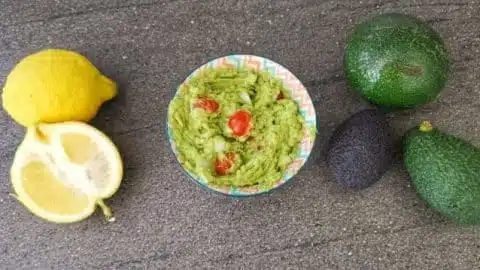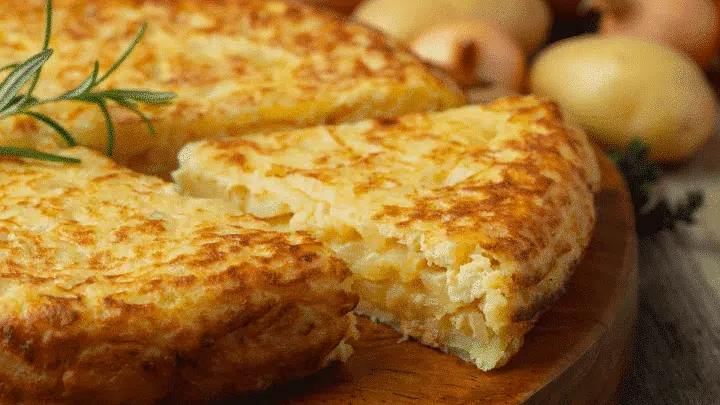Curious about what’s included in a Spanish breakfast menu? You are in for a treat! Here are simple yet satisfying Spanish breakfast foods you need to try right now.
Breakfast is a favorite time for many of us. It is when we commonly eat comforting food that puts us in a positive attitude for the day.
Breakfast is also referred to as the most important meal of the day.
They say that the more packed in nutrients your morning meal is, the more energy you will have to fuel your day.
Do you know what a good way to start your day is?
A lovely Spanish breakfast menu!
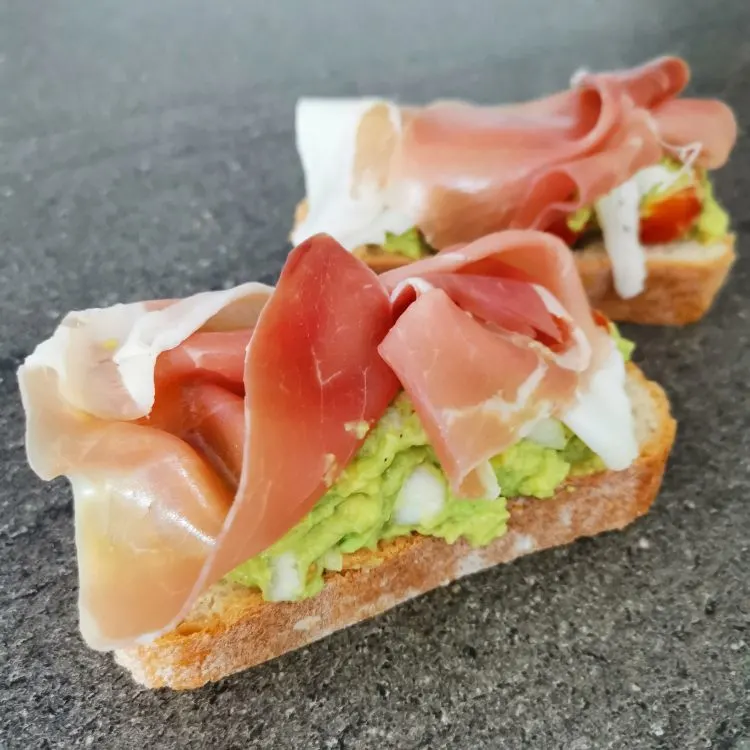
However, be warned… It does not necessarily follow the “the more, the merrier” kind of meal in the morning. On the contrary, it is simple, straightforward, and, a lot of times, sweet!
What do Spanish people eat for breakfast, anyway?
What part of it breaks the typical breakfast variety?
Spanish breakfast foods may appear small in portion and not filling at all, and we can’t blame you for thinking so.
However, wait until you hear about “second breakfast,” a heavy meal that comes between Spain’s breakfast and lunch.
While people may try calling it brunch, we are not sure if it can be called so.
Keep in mind that Spanish lunch is typically served between two and three PM – a time wherein others around the world are already having afternoon snacks.
If you are visiting Spain, treat yourself to a traditional Spanish breakfast.
Not only is it loaded with essential energy-giving nutrients to last you at least until the next meal, but it is also teeming with all the bold flavors the country is well-known for.
If you are keen to try some of them at the comfort of your home, make sure to check out the Spanish breakfast food recipes at the end of the article!
1. Toasted bread with tomato, olive oil, and ham (Pan Con Tomate, Jamon y Aceite)

Tostada in English means toasted bread. This versatile food item is commonly partnered with combinations of tomato, olive oil, and ham.
In some regions of Spain, there will be a special tostada being whipped up each morning.
In Catalonia and Murcia, they go for the simple pan con tomate. In Andalusia, they have what they call tostada con Manteca – toast served with red-colored lard.
2. Spanish Omelet (Tortilla Española)
As in many breakfast menus, eggs are indispensable. In Spain, tortilla española is one of their go-to dish in the morning.
A traditional Spanish omelet will have only a few ingredients: egg, potato, and salt. That is why it is also called pincho de tortilla, tortilla de patata, or potato omelet.
The doneness of your Spanish omelet will depend solely on your preference.
Spanish omelet is enjoyed by many as their second breakfast. While others will pair it with a café con Leche, some choose to eat it with a caña, a small draft beer.
Tortilla Española is deeply rooted in Spanish culinary traditions and has been a staple dish for centuries.
It originated in the region of Spain called Extremadura and gradually spread throughout the country.
Today, it is considered one of the most emblematic and representative dishes of Spanish cuisine.
The tortilla holds a special place in the hearts of Spaniards, often enjoyed as a tapa, a light meal, or even as part of a picnic.
3. Torrijas – Spanish Breakfast Foods
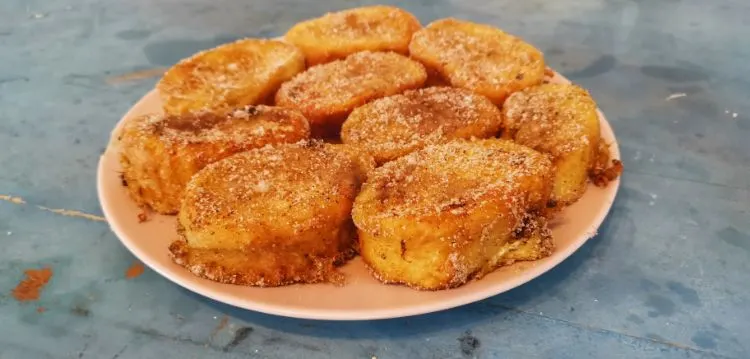
Torrijas are among the Spanish breakfast foods recipes that are easy to make.
In fact, I recently followed this delicious & easy Spanish torrijas recipe, and it did not disappoint!
At first glance, you will say that torrijas are very similar to bread pudding or French toast.
However, as you will see in my recipe, torrijas are actually fried in olive oil.
Moreover, it is dipped in flavored milk before it is dipped in egg – something very different from pudding and French toast.
4. Café con Leche
A typical Spanish breakfast is not complete without a café con Leche. This drink is basically coffee and milk.
To make café con Leche, a shot of espresso is dosed with steamed milk. This hot beverage is similar to America’s cafe latte.
To truly understand the significance of café con Leche in Spain, we must recognize its deep-rooted cultural importance.
Spaniards consider it an integral part of their breakfast routine, and no morning meal is complete without a steaming cup of this delightful elixir.
The beverage’s popularity stems from its ability to energize and invigorate, fueling individuals for the day ahead.
Moreover, café con Leche serves as a social catalyst, bringing friends, families, and even strangers together over a shared appreciation for its captivating aroma and exquisite taste.
5. Churros
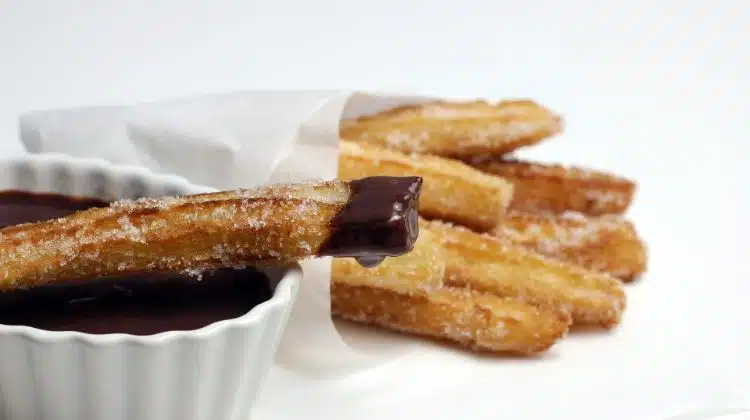
Another typical Spanish breakfast food is a churro. Some of you might book a one-way ticket to Spain upon learning this – churros for breakfast?!
There is even more: it is commonly served with Spanish hot chocolate.
The pastry is piped using a star-shaped tip, freshly fried, and dusted with cinnamon and sugar. The hot chocolate on the side is made for dipping.
Churros are best paired with café con Leche!
6. Spanish Cupcakes (Magdalenas)
Magdalenas are Spanish lemon cupcakes that are best enjoyed with a cup of café con Leche.
This type of cupcake is rich and tangy in taste yet light and fluffy in texture. It is quite similar to the French’s madeleines.
Magdalenas are not only eaten during breakfast. It is also enjoyed as a light snack during the day. You can easily find these baked treats in grocery stores in Spain.
Magdalenas have a long history dating back to the 18th century in Spain. It is believed that these cupcakes were named after Mary Magdalene, a biblical figure known for her devotion.
Originally, Magdalenas were baked in convents and monasteries as a simple yet delightful treat for the nuns and monks.
Over time, they gained popularity among the general public and became a staple in Spanish households.
7. Sandwiches (Bocadillos)
Sandwiches (in Spanish: Bocadillos) are another traditional Spanish breakfast item.
Bocadillos hold a special place in Spanish cuisine and culture. They are a beloved culinary tradition that can be found across the length and breadth of Spain.
These sandwiches are an integral part of Spanish gastronomy, enjoyed as a quick snack, a light lunch, or even a satisfying dinner.
Bocadillos are not just a meal; they represent a way of life, encapsulating the spirit of Spanish simplicity, flavor, and conviviality.
You can order your Bocadillo with all kind of topping, like for example with ham (Bocadillo de jamón), cheese (Bocadillo de queso) or scrambled eggs (Bocadillo de huevos revueltos).
Some of the different regions in Spain have specific bread that they like to use for their sandwiches.
The most-used type of bread all over the country, though, is the classic baguette which people call barra.
8. Fresh Juices
You will be delighted with all the fresh juice options you can get in Spain!
Most (if not all) cafeterias and restaurants have juicers to squeeze all the liquid goodness out of the fruits in season.
Unlike the ones that come in tetra paks and some notorious for having multiple shots of sugar syrup, Spain likes to keep their juices pure.
Be sure to order one to come with your traditional Spanish breakfast!
Spanish Breakfast Recipes
Tempted with all the Spanish breakfast foods I just listed above? Why not make some at your home right now?
You don’t have to be in one of Spain’s restaurants to have a taste of their beloved breakfast items. Most of the dishes the locals enjoy in the morning call for very few items from your pantry.
Also – if I may add – this is a nice and valid reason to have chocolate and other sweet items for breakfast!
Spice up your morning table by cooking up a Spanish menu for breakfast.
These Spanish breakfast recipes are all easy to make and delicious to eat!
Typical Spanish Breakfast Foods
Pan con Tomate Recipe (Toasted bread with tomato, olive oil, and ham)
Pan con Tomate, jamón y aceite, or toasted bread with tomato, olive oil, and ham is another popular, Spanish breakfast item.
Delicious & Easy Spanish Torrijas Recipe
Torrijas have long been part of the Spanish cuisine. Know how to make this decadent delight with our easy-to-follow Spanish Torrijas recipe.
Frequently Asked Questions
What are typical Spanish breakfast dishes?
Typical Spanish breakfast dishes include “Pan con Tomate, Jamon y Aceite” (toasted bread with tomato, olive oil, and ham), “Tortilla Española” (Spanish omelette), “Torrijas” (Spanish-style French toast), “Café con Leche” (coffee with milk), “Churros” (fried pastry), and “Magdalenas” (Spanish lemon cupcakes).
What is “Pan con Tomate, Jamon y Aceite”?
“Pan con Tomate, Jamon y Aceite” is a typical Spanish breakfast dish where toasted bread is served with tomato, olive oil, and ham. It’s a simple yet delicious combination that is enjoyed for breakfast in some regions of Spain.
What is “Tortilla Española”?
“Tortilla Española” is a traditional Spanish omelette and one of the most popular breakfast dishes in Spain. It consists primarily of eggs, potatoes, and salt, and can be cooked to different levels of doneness depending on personal preference. Some people enjoy it with a “Café con Leche” (coffee with milk), while others pair it with a small beer called “Caña.”
How are “Churros” served?
“Churros” are another typical Spanish breakfast treat. They are fried in a star-shaped form, dusted with cinnamon and sugar, and often served with hot Spanish chocolate for dipping. You can dip the churros in the chocolate and enjoy them alongside a cup of “Café con Leche.”
What types of juices are offered with a traditional Spanish breakfast?
With a traditional Spanish breakfast, you’ll be delighted by the variety of fresh juice options available. Most cafeterias and restaurants have juicers to extract the pure goodness from seasonal fruits. Unlike packaged juices that may contain added sugars, Spain prefers to keep their juices pure and natural. Make sure to order a refreshing glass of fresh juice to accompany your traditional Spanish breakfast experience.
How is a Spanish breakfast different from typical breakfast varieties?
Spanish breakfasts often break away from the typical variety by being simple, straightforward, and sometimes sweet. They may appear small in portion, but they are designed to provide essential energy-giving nutrients until the next meal. Additionally, Spain has a concept of “second breakfast,” which is a heavier meal between breakfast and lunch.
What are torrijas in Spanish cuisine?
Torrijas are a delicious Spanish breakfast food similar to bread pudding or French toast. However, unlike those dishes, torrijas are fried in olive oil and dipped in flavored milk before being dipped in egg. They are a delightful treat to try and are easy to make at home.



